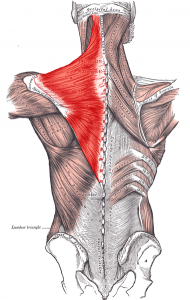 In the last few posts I have been writing about classic weight lifting muscles—the latissimus dorsi, the pectoralis major and now the trapezius. They are surface muscles that are often focused on in the aesthetics of body building.
In the last few posts I have been writing about classic weight lifting muscles—the latissimus dorsi, the pectoralis major and now the trapezius. They are surface muscles that are often focused on in the aesthetics of body building.
Personally I have never understood the building of large hard muscles and feel that there is a sound argument that hard muscles are actively bad for you. But it makes sense that athletes in high impact sports (wrestling, football) should have very large, hard and powerful muscles.
The trapezius is a large diamond shaped muscle that connects on the occipital bone at the base of the head, attaches to the shoulder girdle on the collar bone and the shoulder blade, and along the spine from the base of the rib cage (T12) all the way up to the head as well as connecting through the nuchal ligament.
The trapezius is often separated into three sections—upper, middle and lower traps serving different functions.
The body is a series of hanging structures and the shoulder girdle hangs from the head via the trapezius and other muscles of the head and neck, and the arm in large part hangs from the upper trapezius. The middle traps hold the shoulder blades onto the back as well as retracts them.
The lower trapezius rotates the shoulder blade in and draws it down the back. The trapezius as a whole, as well as the pectoralis minor and the next couple of muscles I post about (rhomboids and serratus anterior), is designed to stabilize the shoulder blade or scapula on the back when performing any given function.
The lower trapezius is meant to counteract the round shouldered posture created by the tight pectoralis minor of the previous posts. My chiropractor, the invaluable Lisa Kirsch, says that very few people have lower trapezii that are working effectively (or in her language “turned on”), and from working with clients and watching people in yoga class, I agree with her. In many cases the tightness and tension of pectoralis minor simply overrides the best efforts of the lower trapezius.
The next few posts will cover other muscles around the shoulder blades in addition to the trapezius and hopefully connect how they are all meant to work together harmoniously.
***
